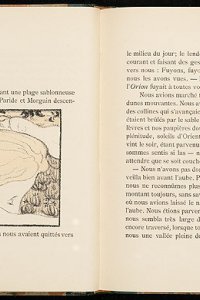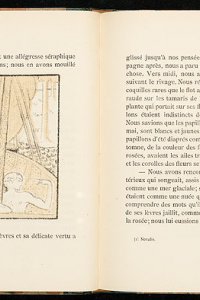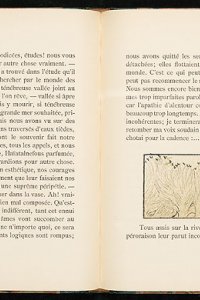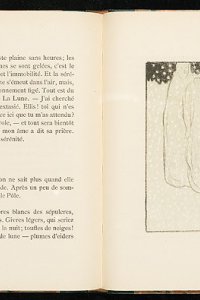Le voyage d'Urien
Year: 1893
Author: André Gide (1869 - 1951)
Artist: Maurice Denis (1870 - 1943)
Publisher: Librairie de l'Art indépendant
In his theoretical texts, Maurice Denis predicted that authors and artists would start collaborating in new ways. He was not referring to illustrations and decorations – it had to be more than that. The collaboration between Gide and Denis started after Gide had seen some unpublished drawings for Verlaine's Sagesse in 1891. In August 1892, Gide wrote that the text was not yet finished. He produced revisions in order to equal the level of the illustrations at a time when Denis had yet to start work on his contribution; perhaps Gide still had the illustrations for Sagesse in mind. But Denis had already suggested to draw borders: the text was to be framed by decorations. Gide left the page design to him, but he did emphasise the division of the text into three chapters, insisting that the illustrations for the chapters would feature different colour tones ('les trois parties qui le composent doivent être d'une tonalité toute différente'). And indeed: the colour does change from chamois to ochre to green.
In long-winded but polite sentences he wrote that his idea for the book may sound pedantic or vague, as they were after all different kinds of artists: 'êtes-vous comme moi?' This correspondence demonstrates that the artist's book – with its inherent patterns of collaboration – was still in its infancy. The publisher also let himself be heard. Bailly loved the fact that Denis would produce his own lithographs (the artist's drawings were usually applied to the stone plate by a studio assistant). He did fear that a lithographed text, however, would leave something to be desired. The text was therefore printed separately, by Paul Schmidt, while the lithographs were printed by Edward Ancourt.
In August 1892, Denis suggested placing large lithographs throughout the book, similar in size to the blocks of text. He proposed placing a lithograph like that in the middle of the page, with several lines of text above and below it, so the entire type area would remain balanced with the facing full page of text. This has been done on a few occasions, bringing a sense of variety to the page layout. These Symbolistic lithographs picture events from the story. Small, more abstract lithographs have been included at the beginning of the chapters, and there are also lithographs a few lines high that run along the entire width like an illustrated band across the page ('on pourrait couper vers le milieu la page par une bande de dessin'). The larger lithographs also have various different sizes. All the lithographs support the book's sensual dream-like nature, for instance by showing eyes that are mostly closed, and by including arabesques in Japanese style. The book featured a total of thirty lithographs and one wood engraving (the cover illustration). Denis wanted the book to appear severe and mysterious, its style both Renaissance and medieval. He had by then already abandoned the idea of borders. And, wrote Denis, they would still have to discuss the colours. He came to Paris especially to do so.
In April 1893, the printer found out that he did not have enough letters to set the entire text at once. He therefore printed the later chapters separately from the rest. The book was printed in eight-page quires, so Gide's impression that he printed each set of twenty pages separately must have been based on a misunderstanding. The typography was determined by Denis. 300 copies of the book were printed, besides which a single copy was printed on Japanese paper (now part of the Harvard College Library) and one on Chinese paper. The book was published in May 1893. Denis was not entirely satisfied, henceforth no longer opting for lithography. Gide reported on a few voices from the press: Paul Adam felt that the illustrations at least gave Gide's frosty story some semblance of warmth; Huysmans thought that the interesting and curious illustrations were created for dreams, and Maeterlinck called the illustrations a parallel poem, making him the first to recognise the nature of the artists' book. Henri de Régnier also felt that Denis' interpretation maintained a respectable distance from the text ('Le jeune Denis a fait son devoir et son interpretation est à bonne distance du texte et d'une imagerie charmante'). The collaboration was sealed by the way in which the names were listed as equals on the title page, as co-authos: 'André Gide, Maurice Denis'. This journey had been made together, Gide wrote in the copy for Denis: 'ce voyage est vraiment fait ensemble.'
Bibliographical description
Description: Le voyage d'Urien / André Gide ; [lithographies de] Maurice Denis. - Paris : Librairie de l'Art indépendant, 1893. - 105 p. : ill. ; 21 cm
Printer: Paul Schmidt (Paris) (text), Edw. Ancourt (Paris) (lithographs)
Edition: 300 exemplaren
This copy: Number 292 van de 300 on vélin
Bookbinder: A. Devauchelle
Bibliography: Bénézit 4-446 ; Carteret IV-184 ; Hogben 5 ; Monod 5370
Shelfmark: KW Koopm M 802M
References
- Edmond Bailly, Le chant des voyelles comme invocation aux dieux planétaires suivi d'une restitution vocale avec accompagnement. Nice, Boumendil, 1976
- Jean-Paul Bouillon, Maurice Denis. Genève, Skira, 1993
- Pierre Cailler, Catalogue raisonné de l'œuvre gravé et lithographié de Maurice Denis. Nouv. éd. San Francisco, Alan Wolfsy Fine Arts, 2000
- Paul van Capelleveen, Sophie Ham, Jordy Joubij, Voices and visions. The Koopman Collection and the Art of the French Book. The Hague, Koninklijke Bibliotheek, National Library of the Netherlands; Zwolle, Waanders, 2009
- Maurice Denis, Journal. Tome I (1884-1904). Paris, La Colombe, 1957
- André Gide, Henri de Régnier, Correspondance (1891-1911). Lyon, Presses Universitaires de Lyon, 1997
- André Gide, Maurice Denis, Correspondance 1892-1945. Paris, Gallimard, 2006
- Jacques Guignard, 'Maurice Denis et l'illustration du livre', in: Maurice Denis, illustrateur. Tours, Association des amis de la Bibliothèque municipale et du Musée des Beauxarts de la ville de Tours, 1966, p. 11-23
- François Lesure, Debussy. Genève, Minkoff & Lattès, 1980
- Victor-Emile Michelet, Les compagnons de la Hiérophanie. Souvenirs du mouvement hermétiste à la fin du XIXe siècle. Paris, Dorbon-aîné, 1937
- The turn of the century 1885-1910. Art Nouveau, Jugendstil books. Boston, Harvard University, 1970
- Gerard Vaughan, 'André Gide and Maurice Denis, Le Voyage d'Urien', in: Print quarterly, 1 (1984) 3 (sept.), p. 173-187





